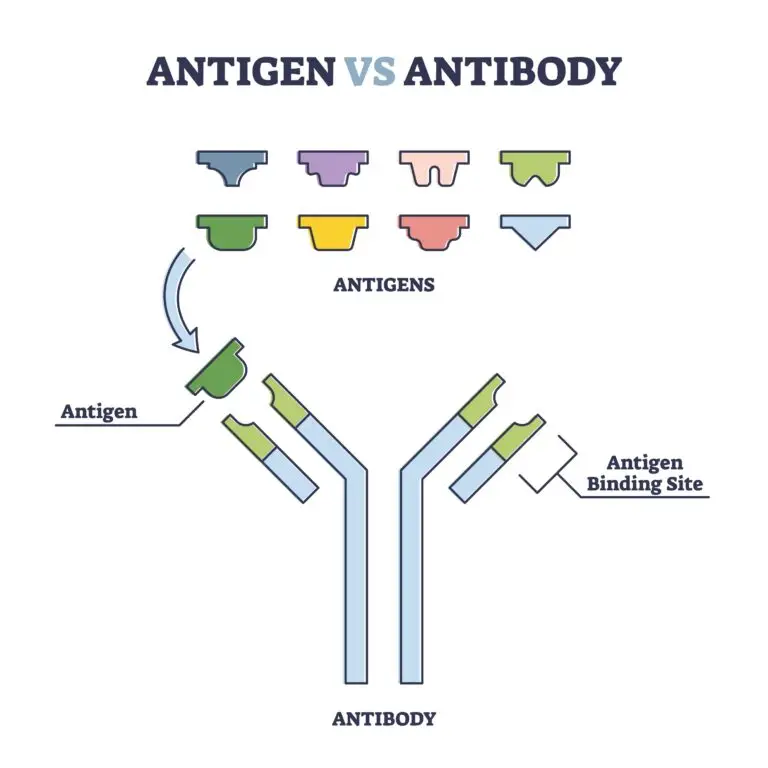Antigen

Table of Contents
What is an Antigen?
An antigen is a molecule or molecular structure recognized by the immune system as foreign or non-self. Antigens stimulate an immune response, leading to the production of antibodies or the activation of immune cells.
Antigens can be found on the surface of pathogens, such as bacteria and viruses, and on the surface of non-infectious entities, including cells, proteins, and molecules from foreign substances.
Understanding Antigens and Immune Responses
Foreign Recognition
Antigens are molecules or molecular structures the immune system recognizes as foreign or non-self, prompting an immune response. These substances can be proteins, polysaccharides, lipids, or nucleic acids and are typically found on the surface of pathogens, such as bacteria, viruses, fungi, or parasites, as well as on cancer cells and, in some cases, transplanted tissues or organs.
The immune system detects antigens through specific receptors on immune cells, such as B and T cells. These receptors are designed to bind to specific structures on antigens, allowing the immune system to identify and target the foreign entity.
Once an antigen is recognized, it can activate the immune system, producing antibodies (by B cells) that specifically target the antigen for neutralization or destruction. T cells can also be activated to attack cells that carry these antigens directly.
The immune system can remember previous encounters with specific antigens through memory cells. This memory leads to a more rapid and robust response upon subsequent exposures to the same antigen, which is the principle behind vaccinations.
Types of Antigens
- Pathogen-Derived Antigens: Antigens on the surface of pathogens, such as bacteria, viruses, fungi, and parasites.
- Self-Antigens: Normally, the immune system recognizes the body’s cells and molecules as “self,” but autoimmune conditions can lead to recognizing self-antigens as foreign.
- Allergens: Substances that can induce allergic reactions, acting as antigens to which the immune system overreacts.
Antigenic Determinants (Epitopes)
pecificity of Immune Response: Epitopes are the precise sites on an antigen where the binding of antibodies or immune cell receptors occurs. This specific interaction ensures that the immune response targets particular pathogens or foreign molecules accurately, minimizing damage to the body’s own cells.
Structure of Epitopes: Epitopes can be linear, consisting of a sequence of amino acids in a protein, or conformational, where the three-dimensional structure of the protein forms the epitope. This structural diversity allows a vast array of unique epitopes to exist, even on a single antigen.
Recognition and Binding: Antibodies have variable regions that are shaped to fit specific epitopes. When an antibody encounters its corresponding epitope, it binds to it with high specificity. This binding can neutralize the pathogen directly or mark it for destruction by other immune cells.
Activation of Immune Cells: The binding of epitopes to receptors on B cells and T cells plays a crucial role in the activation of these immune cells. For T cells, particularly, the epitopes need to be processed and presented by other cells in the body (antigen-presenting cells) along with major histocompatibility complex (MHC) molecules.
Immunological Memory: Once an immune response to a specific epitope is generated, the immune system can remember it, leading to a quicker and more robust response upon subsequent exposures to the same epitope, which is the basis for the effectiveness of vaccines.
Immune Response
The immune response begins when the immune system recognizes an antigen, a foreign substance in the body. Once detected, the immune system eliminates or neutralizes the antigen.
This process includes producing antibodies, activating various immune cells, and creating immunological memory. This memory allows the immune system to respond more quickly and effectively if the antigen is encountered again in the future.
Adaptive Immune Response
Antigens are a key component of the adaptive immune response, where the immune system “learns” to recognize and respond more efficiently upon subsequent exposures.
Antigen-Presenting Cells (APCs)
Antigenic determinants, or epitopes, are specific regions or parts of an antigen molecule that are recognized and bound by immune cells, such as antibodies, B cells, or T cells. These regions are crucial for the specificity of the immune response.
Vaccine Induction of Immunity
Vaccines often contain weakened or inactivated forms of pathogens or their components to stimulate an immune response and the production of memory cells. This protects against future encounters with the actual pathogen.
Related Links
The Immune System
What are Antibodies?
Pathogens
Antibodies